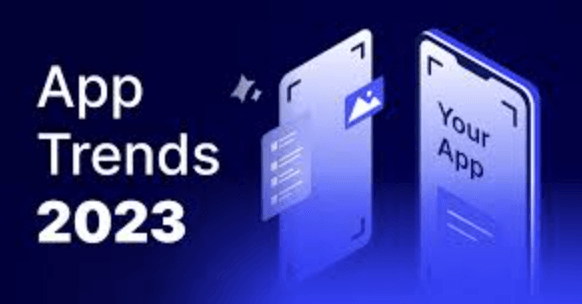Top Mobile App Development Trends for 2024

Introduction
As we move into 2024, the landscape of mobile app development is evolving at an unprecedented pace. The rapid growth in technology, coupled with changing consumer behaviors, is driving developers to innovate and adapt to new trends. From advancements in AI to the rise of 5G, the trends emerging in mobile app development are poised to redefine how we interact with technology. This article delves into the most significant trends in mobile app development for 2024, offering insights that will help businesses, developers, and tech enthusiasts stay ahead of the curve.
The Rise of AI and Machine Learning in Mobile Apps
Artificial Intelligence (AI) and Machine Learning (ML) have been transformative forces in mobile app development. In 2024, their impact is set to grow even further. AI and ML are no longer just buzzwords; they are integral to creating personalized user experiences, enhancing app security, and automating processes.
One of the most notable trends is the integration of AI-driven chatbots and virtual assistants within apps. These AI tools can handle customer inquiries, provide recommendations, and even predict user behavior. With advancements in natural language processing (NLP), these virtual assistants are becoming more intuitive and capable of understanding complex commands, making them indispensable in apps ranging from e-commerce to customer service.
Moreover, AI and ML are being used to analyze vast amounts of data, enabling apps to deliver personalized content and offers to users. This level of personalization not only improves user satisfaction but also boosts engagement and retention rates. For businesses, the ability to predict user behavior and tailor their offerings accordingly can be a game-changer.
5G Technology Revolutionizing Mobile Apps
The rollout of 5G technology is one of the most anticipated developments in the tech world, and its impact on mobile app development is profound. With 5G, mobile apps will be able to leverage faster data speeds, lower latency, and enhanced connectivity, leading to more immersive and responsive user experiences.
In 2024, we can expect to see a surge in the development of apps that require high-speed connectivity, such as augmented reality (AR) and virtual reality (VR) applications. These apps, which were previously limited by the constraints of 4G, will now be able to offer seamless, real-time experiences. For instance, AR-based shopping apps will allow users to virtually try on clothes or preview furniture in their homes with unprecedented accuracy.
Additionally, 5G will enable the growth of IoT (Internet of Things) applications. With more devices connected to the internet, mobile apps will need to manage and process data from various sources efficiently. This connectivity will lead to the development of smarter apps that can control and interact with multiple IoT devices, offering users a unified and integrated experience.
The Expansion of Augmented Reality (AR) and Virtual Reality (VR)
Augmented Reality (AR) and Virtual Reality (VR) have been gaining traction in recent years, but 2024 is set to be a breakthrough year for these technologies in mobile app development. The widespread adoption of 5G will play a crucial role in enhancing AR and VR experiences by providing the necessary speed and bandwidth.
AR and VR are no longer confined to gaming; they are making their way into various industries, including retail, real estate, education, and healthcare. For instance, AR is being used in retail apps to create interactive shopping experiences where customers can visualize products in their environment before making a purchase. Similarly, VR is transforming the real estate industry by offering virtual property tours, saving time for both buyers and sellers.
In education, AR and VR are being utilized to create immersive learning experiences that go beyond traditional methods. Students can explore historical sites, conduct science experiments, or even travel to outer space, all from the comfort of their classroom or home. This trend is expected to grow as more educational institutions and developers recognize the potential of AR and VR in enhancing learning outcomes.
Blockchain Technology Enhancing App Security
With the increasing amount of sensitive data being handled by mobile apps, security has become a top priority for developers. In 2024, blockchain technology is emerging as a powerful tool for enhancing app security and ensuring data integrity.
Blockchain’s decentralized nature makes it difficult for hackers to manipulate data, providing a secure environment for transactions and data storage. This is particularly important for apps in the finance, healthcare, and legal sectors, where data breaches can have severe consequences.
Moreover, blockchain can be used to create decentralized apps (dApps) that operate on a peer-to-peer network, eliminating the need for a central authority. This not only enhances security but also reduces the risk of downtime and ensures that the app remains operational even if part of the network fails.
In addition to security, blockchain is being used to enhance transparency and trust in transactions. For example, supply chain management apps are using blockchain to track the origin and journey of products, providing consumers with verifiable information about the items they purchase.
The Growing Importance of Progressive Web Apps (PWAs)
Progressive Web Apps (PWAs) have been around for a few years, but they are gaining significant momentum in 2024. PWAs combine the best of web and mobile apps, offering a fast, reliable, and engaging user experience without the need to download an app from the store.
One of the key advantages of PWAs is their ability to work offline or in areas with poor connectivity. This is achieved through the use of service workers, which cache essential resources and ensure that the app remains functional even when the user is not connected to the internet. For users in regions with unstable internet connections, PWAs offer a more accessible and reliable option.
PWAs also have a smaller footprint compared to native apps, which means they take up less space on the user’s device. This is particularly beneficial in markets where low-end smartphones with limited storage are prevalent. Additionally, PWAs can be updated automatically, eliminating the need for users to manually download updates.
From a development perspective, PWAs offer a cost-effective solution as they require less time and resources to build and maintain compared to native apps. This is especially attractive to small and medium-sized businesses that want to provide a mobile experience without the overhead of developing and supporting separate iOS and Android apps.
Cross-Platform Development Tools: The Future of App Development
As the demand for mobile apps continues to grow, developers are increasingly turning to cross-platform development tools to streamline the development process. In 2024, these tools are expected to become even more sophisticated, enabling developers to create high-quality apps that run seamlessly on multiple platforms with a single codebase.
Frameworks like Flutter, React Native, and Xamarin have been at the forefront of this trend, allowing developers to write code once and deploy it across iOS, Android, and even web platforms. This not only reduces development time and costs but also ensures a consistent user experience across devices.
The advancements in cross-platform development tools are also addressing some of the performance issues that have historically plagued these frameworks. In 2024, we can expect to see even more optimized and efficient cross-platform apps that rival their native counterparts in terms of speed, responsiveness, and user experience.
Moreover, with the introduction of new programming languages and tools, developers will have more flexibility and options when it comes to creating cross-platform apps. This trend is likely to continue as businesses seek to reach a wider audience without compromising on quality.
Voice Technology and the Rise of Voice-Activated Apps
Voice technology has made significant strides in recent years, and 2024 is poised to be the year it becomes a mainstream feature in mobile apps. With the proliferation of smart speakers and voice-activated devices, consumers are becoming more accustomed to using voice commands to interact with technology.
In response, developers are increasingly incorporating voice technology into mobile apps, allowing users to perform tasks hands-free. This trend is particularly relevant for apps in the navigation, shopping, and home automation categories, where voice commands can enhance convenience and usability.
Voice-activated apps are also being used to improve accessibility for users with disabilities. By providing an alternative to touch-based interactions, these apps make it easier for people with mobility or vision impairments to use and benefit from mobile technology.
Furthermore, advancements in natural language processing (NLP) are making voice-activated apps more accurate and capable of understanding complex commands. In 2024, we can expect to see more apps that leverage voice technology to offer a seamless, intuitive, and user-friendly experience.
On-Demand Apps: Meeting the Needs of the Modern Consumer
On-demand apps have revolutionized the way we access services, from food delivery and transportation to healthcare and home maintenance. In 2024, the on-demand economy is expected to grow even further, with more industries and services being brought into the fold.
The success of on-demand apps lies in their ability to provide instant access to goods and services with just a few taps on a smartphone. As consumer expectations continue to rise, developers are focusing on creating apps that offer a seamless, efficient, and personalized experience.
In 2024, we can expect to see more niche on-demand apps catering to specific markets and needs. For example, hyper-local delivery apps that focus on specific neighborhoods or communities are likely to become more popular, offering a more personalized and efficient service.
Moreover, advancements in AI and data analytics are enabling on-demand apps to better predict and respond to user needs. This means that users can expect faster response times, more accurate recommendations, and a higher level of personalization in their interactions with these apps.
Mobile Wallets and the Future of Digital Payments
As mobile commerce continues to grow, so does the adoption of mobile wallets and digital payment solutions. In 2024, mobile wallets are expected to become even more prevalent, driven by the increasing demand for contactless payments and the convenience they offer.
Mobile wallets like Apple Pay, Google Wallet, and Samsung Pay have already gained significant traction, allowing users to make secure payments with their smartphones. In 2024, we can expect to see further integration of mobile wallets with other services, such as loyalty programs, ticketing, and even identification.
The rise of cryptocurrency is also influencing the mobile wallet landscape. More apps are beginning to support cryptocurrency transactions, providing users with a broader range of payment options. This trend is expected to continue as more consumers and businesses embrace digital currencies.
Moreover, the growth of mobile wallets is not limited to developed markets. In emerging markets, where access to traditional banking services may be limited, mobile wallets are providing a vital solution for financial inclusion. As more people gain access to smartphones, mobile wallets are becoming the preferred method of payment, enabling users to participate in the digital economy.
The Impact of IoT on Mobile App Development
The Internet of Things (IoT) is rapidly expanding, and its impact on mobile app development is profound. In 2024, the number of IoT-connected devices is expected to reach new heights, creating a wealth of opportunities for mobile app developers.
IoT apps enable users to control and monitor their connected devices from a single interface, providing convenience and efficiency. From smart home systems to wearable health devices, IoT apps are making it easier for users to interact with the world around them.
One of the key trends in 2024 is the development of more intelligent and autonomous IoT apps. With the help of AI and machine learning, these apps are becoming capable of making decisions and taking actions without human intervention. For example, a smart thermostat app could automatically adjust the temperature based on the user’s habits and preferences, or a security app could alert users to potential threats in real-time.
Moreover, as IoT devices become more interconnected, the need for secure and reliable communication between devices is paramount. Developers are focusing on creating apps that not only offer seamless integration but also ensure the security and privacy of user data.
Wearable Technology and Its Integration with Mobile Apps
Wearable technology is another area that is set to see significant growth in 2024, with more sophisticated devices and applications emerging. From fitness trackers to smartwatches, wearables are becoming an integral part of our daily lives, and their integration with mobile apps is driving innovation in the tech industry.
In 2024, we can expect to see more advanced wearables that offer a wider range of functions, such as health monitoring, communication, and even payment processing. These devices will be more closely integrated with mobile apps, allowing users to access and control various features directly from their wrist.
The healthcare industry, in particular, is set to benefit from the integration of wearables and mobile apps. With the ability to monitor vital signs, track physical activity, and even detect early signs of illness, wearables are revolutionizing the way we approach healthcare. Mobile apps play a crucial role in collecting and analyzing this data, providing users with actionable insights and helping healthcare providers deliver better care.
Furthermore, the fashion and entertainment industries are also exploring the potential of wearables. Smart clothing and accessories that interact with mobile apps are becoming more popular, offering users a unique and personalized experience. As wearable technology continues to evolve, the possibilities for mobile app development are endless.
Cloud-Based Mobile Apps: Enhancing Efficiency and Scalability
Cloud technology has been a game-changer for many industries, and its impact on mobile app development is no exception. In 2024, cloud-based mobile apps are expected to become even more prevalent, offering enhanced efficiency, scalability, and security.
Cloud-based apps store data and perform processing tasks on remote servers, reducing the burden on the user’s device. This not only improves the app’s performance but also allows for more complex and resource-intensive applications to be developed. For users, this means faster load times, less storage space required, and the ability to access their data from multiple devices.
Moreover, cloud technology enables developers to scale their apps more easily. As the user base grows, additional resources can be allocated on the cloud, ensuring that the app continues to perform optimally. This scalability is particularly important for apps that experience rapid growth or seasonal spikes in usage.
In addition to performance and scalability, cloud-based apps offer enhanced security features. With data stored in the cloud, developers can implement robust security measures to protect user information, including encryption, authentication, and regular backups. This is especially crucial for apps that handle sensitive data, such as financial or healthcare apps.
The Evolution of Mobile App Design: Focus on User Experience (UX)
User experience (UX) has always been a critical factor in mobile app development, but in 2024, it is becoming more important than ever. With the growing competition in the app market, providing a seamless, intuitive, and engaging user experience is key to attracting and retaining users.
One of the key trends in UX design for 2024 is the use of micro-interactions. These are small, subtle animations or responses that occur when a user interacts with an app, such as a button press or a swipe gesture. Micro-interactions add a layer of feedback and engagement, making the app feel more responsive and alive.
Another trend is the emphasis on minimalistic and clean design. As mobile devices become more powerful, there is a temptation to add more features and content to apps. However, the best apps in 2024 are those that focus on simplicity and clarity, providing users with a straightforward and enjoyable experience.
Accessibility is also becoming a major focus in UX design. Developers are increasingly considering the needs of users with disabilities, ensuring that their apps are usable by everyone. This includes features such as voice commands, adjustable text sizes, and color contrast settings.
Finally, the integration of AR and VR into mobile app design is creating new opportunities for immersive and interactive experiences. By blending digital and physical worlds, these technologies are taking UX to the next level, offering users a more engaging and memorable experience.
Edge Computing: Bringing Data Processing Closer to the Source
Edge computing is another trend that is set to shape mobile app development in 2024. Unlike traditional cloud computing, where data is processed in a central server, edge computing processes data closer to the source, such as on a local device or a nearby server.
This approach offers several advantages, including reduced latency, improved performance, and enhanced privacy. For mobile apps, this means faster response times and a more seamless user experience, especially for apps that require real-time processing, such as gaming, AR, and IoT applications.
In 2024, we can expect to see more apps leveraging edge computing to deliver high-performance experiences. For example, a mobile game could use edge computing to process graphics and physics calculations locally, reducing the time it takes for the game to respond to user inputs. Similarly, an IoT app could process sensor data on the device itself, rather than sending it to the cloud, enabling faster decision-making and action.
Moreover, edge computing can enhance the security and privacy of mobile apps. By processing data locally, apps can reduce the amount of sensitive information that needs to be transmitted over the internet, minimizing the risk of data breaches and unauthorized access.
Sustainability in Mobile App Development
As environmental concerns become more pressing, sustainability is emerging as a key consideration in mobile app development. In 2024, developers are increasingly focusing on creating apps that are not only efficient and user-friendly but also environmentally responsible.
One of the ways this is being achieved is through the optimization of app performance to reduce energy consumption. By designing apps that require less processing power and memory, developers can help extend the battery life of mobile devices, reducing the need for frequent charging and the associated environmental impact.
In addition to energy efficiency, developers are also exploring ways to reduce the carbon footprint of their apps. This includes using sustainable hosting solutions, minimizing data usage, and encouraging users to adopt eco-friendly practices, such as reducing screen brightness or limiting the use of resource-intensive features.





